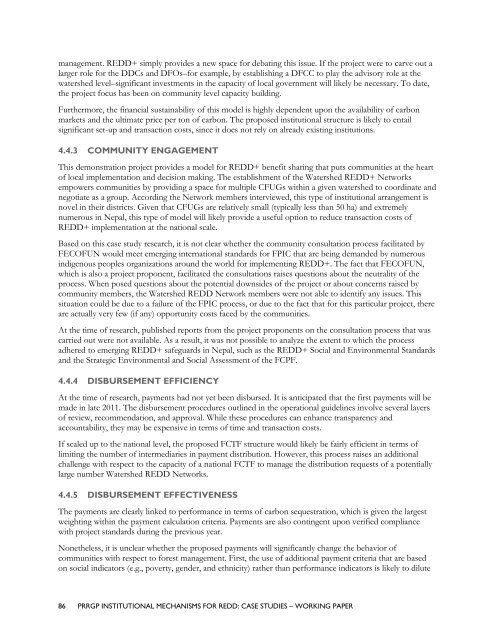Institutional Mechanisms for REDD+ - Case Studies Working Paper
Institutional Mechanisms for REDD+ - Case Studies Working Paper
Institutional Mechanisms for REDD+ - Case Studies Working Paper
Create successful ePaper yourself
Turn your PDF publications into a flip-book with our unique Google optimized e-Paper software.
management. <strong>REDD+</strong> simply provides a new space <strong>for</strong> debating this issue. If the project were to carve out a<br />
larger role <strong>for</strong> the DDCs and DFOs–<strong>for</strong> example, by establishing a DFCC to play the advisory role at the<br />
watershed level–significant investments in the capacity of local government will likely be necessary. To date,<br />
the project focus has been on community level capacity building.<br />
Furthermore, the financial sustainability of this model is highly dependent upon the availability of carbon<br />
markets and the ultimate price per ton of carbon. The proposed institutional structure is likely to entail<br />
significant set-up and transaction costs, since it does not rely on already existing institutions.<br />
4.4.3 COMMUNITY ENGAGEMENT<br />
This demonstration project provides a model <strong>for</strong> <strong>REDD+</strong> benefit sharing that puts communities at the heart<br />
of local implementation and decision making. The establishment of the Watershed <strong>REDD+</strong> Networks<br />
empowers communities by providing a space <strong>for</strong> multiple CFUGs within a given watershed to coordinate and<br />
negotiate as a group. According the Network members interviewed, this type of institutional arrangement is<br />
novel in their districts. Given that CFUGs are relatively small (typically less than 50 ha) and extremely<br />
numerous in Nepal, this type of model will likely provide a useful option to reduce transaction costs of<br />
<strong>REDD+</strong> implementation at the national scale.<br />
Based on this case study research, it is not clear whether the community consultation process facilitated by<br />
FECOFUN would meet emerging international standards <strong>for</strong> FPIC that are being demanded by numerous<br />
indigenous peoples organizations around the world <strong>for</strong> implementing <strong>REDD+</strong>. The fact that FECOFUN,<br />
which is also a project proponent, facilitated the consultations raises questions about the neutrality of the<br />
process. When posed questions about the potential downsides of the project or about concerns raised by<br />
community members, the Watershed REDD Network members were not able to identify any issues. This<br />
situation could be due to a failure of the FPIC process, or due to the fact that <strong>for</strong> this particular project, there<br />
are actually very few (if any) opportunity costs faced by the communities.<br />
At the time of research, published reports from the project proponents on the consultation process that was<br />
carried out were not available. As a result, it was not possible to analyze the extent to which the process<br />
adhered to emerging <strong>REDD+</strong> safeguards in Nepal, such as the <strong>REDD+</strong> Social and Environmental Standards<br />
and the Strategic Environmental and Social Assessment of the FCPF.<br />
4.4.4 DISBURSEMENT EFFICIENCY<br />
At the time of research, payments had not yet been disbursed. It is anticipated that the first payments will be<br />
made in late 2011. The disbursement procedures outlined in the operational guidelines involve several layers<br />
of review, recommendation, and approval. While these procedures can enhance transparency and<br />
accountability, they may be expensive in terms of time and transaction costs.<br />
If scaled up to the national level, the proposed FCTF structure would likely be fairly efficient in terms of<br />
limiting the number of intermediaries in payment distribution. However, this process raises an additional<br />
challenge with respect to the capacity of a national FCTF to manage the distribution requests of a potentially<br />
large number Watershed REDD Networks.<br />
4.4.5 DISBURSEMENT EFFECTIVENESS<br />
The payments are clearly linked to per<strong>for</strong>mance in terms of carbon sequestration, which is given the largest<br />
weighting within the payment calculation criteria. Payments are also contingent upon verified compliance<br />
with project standards during the previous year.<br />
Nonetheless, it is unclear whether the proposed payments will significantly change the behavior of<br />
communities with respect to <strong>for</strong>est management. First, the use of additional payment criteria that are based<br />
on social indicators (e.g., poverty, gender, and ethnicity) rather than per<strong>for</strong>mance indicators is likely to dilute<br />
86 PRRGP INSTITUTIONAL MECHANISMS FOR REDD: CASE STUDIES – WORKING PAPER

















